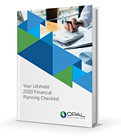5 Tips to Maximize Your Charitable Giving
By Jesse Giordano, CFP®, CAP®, RLP®, CBEC® | December 14, 2023Charitable giving is an important piece of wealth management. It’s about aligning your wealth with your values to support causes that are meaningful to you. There are many ways to do that—and some are more tax-efficient than others. It comes down to finding the right ways to give, which will be unique to your financial situation and goals. Getting time on the calendar with an Opal advisor is the first step to creating a personalized charitable giving plan. Our Charitable Giving Tools Guide is another great starting point. On that note, here are five strategic ways to approach charitable giving.

1. Donor-Advised Funds
Think of a donor-advised fund (DAF) as a holding place for your family’s charitable dollars. That may include cash, assets and other securities—and your contributions are tax-deductible. You’ll also have the opportunity to invest the balance and grow your donations over time. An added bonus is that invested earnings grow tax-free.
You can make grants out of the fund to whatever organizations you choose. During high-earning years, it’s possible to bundle several years’ worth of donations into a single year and take a larger tax deduction. Going forward, you can spread your distributions out over multiple years. DAFs also offer flexibility and are relatively hands-off. A sponsoring organization is tasked with coordinating grants. They’re easy to set up and typically last through the founder’s life or for one more generation.
2. Qualified Charitable Distributions
If you’re 73 or older, you’re obligated to take required minimum distributions (RMDs) from tax-deferred retirement accounts like 401(k)s and traditional IRAs. Keep in mind that these distributions count as taxable income. Depending on how much you withdraw, that could push you into a a higher tax bracket or trigger certain tax deduction phase-outs. Qualified charitable distributions (QCDs) provide a workaround.
If you’re at least 70½, you can donate up to $100,000 to charity from a taxable IRA—and that amount will count toward your RMDs for the year and be excluded from your adjusted gross income. That’s a win-win for everyone. Your donations can also be split between multiple charities. With a QCD, the money goes directly from the IRA to the charity, making for an easy transfer.
3. Gift Annuities and Charitable Remainder Trusts
If you purchase a regular income annuity from an insurance company, you’ll receive recurring fixed income payments in retirement; usually for the rest of your life. With a gift annuity, you strike the same deal with a charity. After making a donation to the charity, you’ll receive a fixed income stream for the remainder of your life. You’ll also get a partial income tax deduction on the money you put in. Any money that’s left over when you pass away will go to the organization.
Charitable remainder trusts (CRTs) follow the same idea but provide more flexibility. Income payments can go to you or your beneficiaries and can range anywhere from 5% to 50% of the trust’s assets. When the trust expires, any remaining assets will be distributed to whichever charities you’ve chosen. There are set-up costs as you’ll need to establish the trust and work with an attorney to get things going. CRTs also tend to require larger contributions, but unlike gift annuities, they allow you to choose your investment model so you’ll have more control over how the money grows.
4. Legacy IRA Rollover
The SECURE Act 2.0, which passed in 2022, brought sweeping changes to retirement planning. That includes the ability to complete a legacy IRA rollover. Beginning in 2024, folks who are 70½ can make a single qualified charitable distribution of up to $50,000 from a tax-deferred IRA to a charitable gift annuity or a charitable remainder trust. In exchange, they’ll receive fixed income payments for a predetermined amount of time, which may be the rest of their life. Any remaining funds will then be absorbed by the charity. Your one-time distribution is not tax-deductible but may count toward your RMDs for the year.
Establishing a charitable gift annuity is simple and cost-free for the donor. The administrative details are normally handled by non-profit organizations. This strategy can provide lifetime retirement income and help deserving charities at the same time.
5. Starting a Non-Profit or Private Foundation
If you’re passionate about a specific cause, you could launch your own public non-profit organization to rally support and donations. It may be something that lives on in your family after you’re gone. Starting a non-profit requires time and energy. You’ll be tasked with creating a board of directors, completing articles of incorporation, and filing for and maintaining tax-exempt status.
Creating a private foundation is another option. While typically more involved to setup compared to a donor-advised fund, it is generally less complex than establishing a public charity. Having a private foundation allows you to to issue grants to non-profits of your choosing. An experienced financial advisor can walk you through the process and will be an important person to have on your team.
Charitable giving can take many forms. What matters most is giving in a way that resonates with your values and supports your long-term financial goals. At Opal Wealth Advisors, creating personalized charitable giving plans is one of our specialties. We listen to our clients and offer strategic ways to help them support the causes that mean most to them. Contact us today and let us help you do the same.
Sources: The University of Michigan, Kitces.com, Northwestern Mutual.
Be a Smart Investor
Stay up-to-date with industry-leading information and news delivered straight to your inbox.
Get our timely insights delivered to your inbox (Blog)
Please remember that past performance may not be indicative of future results. Different types of investments involve varying degrees of risk, and there can be no assurance that the future performance of any specific investment, investment strategy, or product (including the investments and/or investment strategies recommended or undertaken by Opal Wealth Advisors, LLC [“OWA]), or any non-investment related content, made reference to directly or indirectly in this commentary will be profitable, equal any corresponding indicated historical performance level(s), be suitable for your portfolio or individual situation, or prove successful. Due to various factors, including changing market conditions and/or applicable laws, the content may no longer be reflective of current opinions or positions. Moreover, you should not assume that any discussion or information contained in this commentary serves as the receipt of, or as a substitute for, personalized investment advice from OWA. OWA is neither a law firm, nor a certified public accounting firm, and no portion of the commentary content should be construed as legal or accounting advice. A copy of the OWA’s current written disclosure Brochure discussing our advisory services and fees continues to remain available upon request or at www.opalwealthadvisors.com. Please Remember: If you are a OWA client, please contact OWA, in writing, if there are any changes in your personal/financial situation or investment objectives for the purpose of reviewing/evaluating/revising our previous recommendations and/or services, or if you would like to impose, add, or to modify any reasonable restrictions to our investment advisory services. Unless, and until, you notify us, in writing, to the contrary, we shall continue to provide services as we do currently. Please Also Remember to advise us if you have not been receiving account statements (at least quarterly) from the account custodian.



